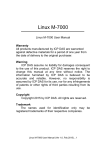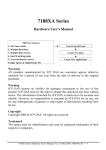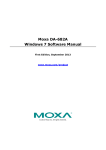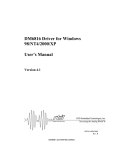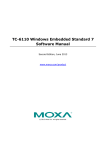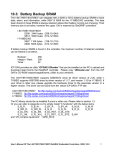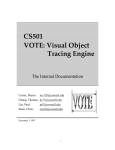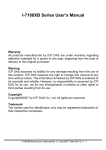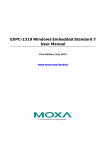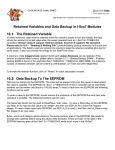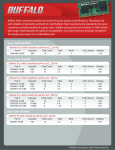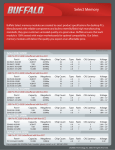Download Manual - ICP DAS USA`s I
Transcript
I-8072 User’s Manual Warranty All products manufactured by ICP DAS are warranted against defective materials for a period of one year from the date of delivery to the original purchaser. Warning ICP DAS assume no liability for damages consequent to the use of this product. ICP DAS reserves the right to change this manual at any time without notice. The information furnished by ICP DAS is believed to be accurate and reliable. However, no responsibility is assumed by ICP DAS for its use, nor for any infringements of patents or other rights of third parties resulting from its use. Copyright Copyright 2002 by ICP DAS. All rights are reserved. Trademark The names used for identification only maybe registered trademarks of their respective companies. 8072 User’s Manual, Sep/2002, Rev. 1.0 ------ 1/15 1. General Introduction The key component of 8072 1. A parallel printer interface 2. Two X-Sockets 3. Eight LED Indicators Note: the 8072 can be installed to slot_0, 1, 2, and 4,5,6,7. It can not be installed in the slot_3. 1. A parallel printer interface It can be used to link to dot-matrix printer or laser printer The software support text mode only. The source code of driver is open for user’s modification User can modify the given driver to support graphic mode of his special printer 2. Two X-Sockets These 2 X-Sockets can support S256 / S512 & AsicKey. The X-Socket does not support Flash memory, 8073 supports flash memory solution. User can install two S256 or one S256 & one AsicKey User can install two S512 or one S512 & one AsicKey The software driver for AsicKey is only open for AsicKey user. 3. Eight LED Indicators: No pre-defined definition User can use all of these 8 LEDs based on his special requirements 4. S256 and S512 can be installed to 8072 or back plane of 8000 (refer to Sec. 9.9.4 of “8410/8411/8810/8811 User’s Manual”). The library is different. For S256 and S512 in 8072, refer to cd/napdos/8000/common/minios7/demo/bc/8072/*.* Or refer to our FTP site: ftp://ftp.icpdas.com/pub/cd/8000cd/napdos/8000/common/minios7/demo/bc/8072/ 8072 User’s Manual, Sep/2002, Rev. 1.0 ------ 2/15 2. Pin Assignments Board Layout X-Socket 2 X-Socket 1 LED * 8 Printer Interface 8072 User’s Manual, Sep/2002, Rev. 1.0 ------ 3/15 Pin Assignment of printer port Strobe 1 2 3 4 5 6 7 8 9 Data 0 Data 1 Data 2 Data 3 Data 4 Data 5 Data 6 Data 7 Ack 14 15 16 17 Auto Feed /Error /Init Printer /Deselect Printer 18 GND 19 GND 20 GND 21 GND 22 GND 23 GND 24 GND 25 GND 10 /Busy 11 Paper Out Printer Online 12 13 8072 User’s Manual, Sep/2002, Rev. 1.0 ------ 4/15 3. Software Driver Init8072 • Description : This subroutine will detect & Initialize the installed 8072 module. • Syntax : WORD Init8072 (WORD SlotNum); • Parameter : SlotNum : [Input] Slot Number. From 0 ~ 7 (Note: the 8072 can not be installed to slot_3) • Return: 0: One 8072 is detected & initialized 1: SlotNum error, must from 0 to 7 2: Read ID Error, can not find an 8072 in this slot • Note: 1. Call this function, Init8072 (SlotNum), before calling the other 8072 functions. 8072 User’s Manual, Sep/2002, Rev. 1.0 ------ 5/15 ShowLed8072 • Description : Write to LED. • Syntax : WORD ShowLed8072 (WORD SlotNum, WORD LedValue); • Parameter : SlotNum : [Input] Slot Number. From 0 ~ 7 (Note: the 8072 can not be installed to slot_3) LedValue: [Input] write value of LED, from 0x00 to 0xff • Return: 0: Write OK 1: SlotNum error, must from 0 to 7 3: no 8072 initialization • Note: 1. Call Init8072 (SlotNum) before calling this function 8072 User’s Manual, Sep/2002, Rev. 1.0 ------ 6/15 ResetPrinter8072 • Description : Send a low pulse to pin 16, /Init Printer, of printer. It can be used to reset this printer. • Syntax : WORD ResetPrinter8072 (WORD SlotNum); • Parameter : SlotNum : [Input] Slot Number. From 0 ~ 7 (Note: the 8072 can not be installed to slot_3) • Return: 0: Write OK 1: SlotNum error, must from 0 to 7 3: no 8072 initialization • Note: 1. Call Init8072 (SlotNum) before calling this function 8072 User’s Manual, Sep/2002, Rev. 1.0 ------ 7/15 ReadPrinterStatus8072 • Description : Read the status byte of printer. • Syntax : WORD ReadPrinterStatus8072 (WORD SlotNum, WORD *Status); • Parameter : SlotNum : [Input] Slot Number. From 0 ~ 7 (Note: the 8072 can not be installed to slot_3) Status: [Input] address of status byte • Return: 0: Write OK 1: SlotNum error, must from 0 to 7 3: no 8072 initialization • Note: 1. Call Init8072 (SlotNum) before calling this function Pin definitions of Printer Status Register (status byte) Bit Number Name Description 0 N/A Reserved 1 N/A Reserved 2 N/A Reserved 3 /Error Normal=1, no error 4 PrinterOnline Normal=1, printer is online 5 Paper Out Normal=0, printer has paper 6 ACK Normal=1 7 /Busy Normal=1, printer not busy 8072 User’s Manual, Sep/2002, Rev. 1.0 ------ 8/15 PrintChar8072 • Description : Print out one character. • Syntax : WORD PrintChar8072 (WORD SlotNum, char ch); • Parameter : SlotNum : [Input] Slot Number. From 0 ~ 7 (Note: the 8072 can not be installed to slot_3) ch: [Input] value to print • Return: 0: Write OK 1: SlotNum error, must from 0 to 7 3: no 8072 initialization • Note: 1. Call Init8072 (SlotNum) before calling this function 8072 User’s Manual, Sep/2002, Rev. 1.0 ------ 9/15 PrintStr8072 • Description : Print out a string of characters. • Syntax : WORD PrintStr8072 (WORD SlotNum, char szBuf []); • Parameter : SlotNum : [Input] Slot Number. From 0 ~ 7 (Note: the 8072 can not be installed to slot_3) szBuf: [Input] starting address of character string • Return: 0: Write OK 1: SlotNum error, must from 0 to 7 3: no 8072 initialization • Note: 1. Call Init8072 (SlotNum) before calling this function 8072 User’s Manual, Sep/2002, Rev. 1.0 ------ 10/15 ReadSramByte8072 • Description : Read one byte of S256 installed in the X-Socket of 8072. Read one byte of S512 installed in the X-Socket of 8072. • Syntax : WORD ReadSramByte8072 (WORD SlotNum, WORD U1U2, DWORD Address, char *ch); • Parameter : SlotNum : [Input] Slot Number. From 0 ~ 7 (Note: the 8072 can not be installed to slot_3) U1U2: [Input] U1U2=1=X_Socket1, U1U2=2=X_Socket2 Address: [Input] address of byte to read, from 0x00 to 0x3ffff for S256 Address: [Input] address of byte to read, from 0x00 to 0x7ffff for S512 ch: address of read data • Return: 0: Write OK 1: SlotNum error, must from 0 to 7 3: no 8072 initialization • Note: 1. Call Init8072 (SlotNum) before calling this function 8072 User’s Manual, Sep/2002, Rev. 1.0 ------ 11/15 WriteSramByte8072 • Description : Write one byte to S256 installed in the X-Socket of 8072. Write one byte to S512 installed in the X-Socket of 8072. • Syntax : WORD WriteSramByte8072 (WORD SlotNum, WORD U1U2, DWORD Address, char ch); • Parameter : SlotNum : [Input] Slot Number. From 0 ~ 7 (Note: the 8072 can not be installed to slot_3) U1U2: [Input] U1U2=1=X_Socket1, U1U2=2=X_Socket2 Address: [Input] address of byte to read, from 0x00 to 0x3ffff for S256 Address: [Input] address of byte to read, from 0x00 to 0x7ffff for S512 ch: data to write • Return: 0: Write OK 1: SlotNum error, must from 0 to 7 3: no 8072 initialization • Note: 1. Call Init8072 (SlotNum) before calling this function 8072 User’s Manual, Sep/2002, Rev. 1.0 ------ 12/15 ReadSramStatus8072 • Description : Read the status byte of S256 installed in the X-Socket of 8072. Read the status byte of S512 installed in the X-Socket of 8072. • Syntax : WORD ReadSramStatus8072 (WORD SlotNum, WORD U1U2, char *ch); • Parameter : SlotNum : [Input] Slot Number. From 0 ~ 7 (Note: the 8072 can not be installed to slot_3) U1U2: [Input] U1U2=1=X_Socket1, U1U2=2=X_Socket2 ch: address of status byte • Return: 0: Write OK 1: SlotNum error, must from 0 to 7 3: no 8072 initialization • Note: 1. Call Init8072 (SlotNum) before calling this function Pin definitions of Printer Status Register (status byte) Bit Number Name Description 0 Battery status 0=Low Battery, 1= High Battery 1 S256 or S512 0=S256, 2~7 N/A Reserved 2=S512 8072 User’s Manual, Sep/2002, Rev. 1.0 ------ 13/15 4. I/O Control Register Use Ti1 to Select Printer/X_Socket The addressing space of printer & X-Socket is overlapped. So we use Ti1 to select printer/X_Socket SetTi1High select printer & I/O control register SetTi1Low read/write to X_Socket Address Mapping of I/O Controller Register (8-bit wide) Offset Address Name Description 0, read Card ID Register For 8072, it is 0x30 4, write Printer Write Data Register write data to printer 5, read Printer Status Register Read the status of printer 6, write Printer Controller Register Control printer & LED 7. write X_Socket Control Register Control X_Socket & LED Printer Write Data Register, base+4, writes Bit Number Name Description 0 Data_0 Bit_0 of printed data 1 Data_1 Bit_1 of printed data 2 Data_2 Bit_2 of printed data 3 Data_3 Bit_3 of printed data 4 Data_4 Bit_4 of printed data 5 Data_5 Bit_5 of printed data 6 Data_6 Bit_6 of printed data 7 Data_7 Bit_7 of printed data 8072 User’s Manual, Sep/2002, Rev. 1.0 ------ 14/15 Printer Status Register, base+5, read Bit Number Name Description 0 N/A Reserved 1 N/A Reserved 2 N/A Reserved 3 /Error Normal=1, no error 4 PrinterOnline Normal=1, printer is online 5 Paper Out Normal=0, printer has paper 6 ACK Normal=1 7 /Busy Normal=1, printer not busy Printer Control Register, base+6, writes Bit Number Name Description 0 Strobe Normal=0, 1=send one byte to printer 1 Auto Feed Normal=0, 1=automatic line feed after CR 2 /Init Printer Normal=1, 0=initialize printer 3 /Deselect Printer Normal=1, 0=deselect printer 4 LED5 Send to led 5 LED6 Send to led 6 LED7 Send to led 7 LED8 Send to led X_Socket Control Register, base+7, writes Bit Number Name Description 0 A9 To X_Socket 1 A12 To X_Socket 2 S0 0=select X_Socket_1, S0 & S1 can not both 0 3 S1 0=select X_Socket_2, S0 & S1 can not both 0 4 LED1 Send to led 5 LED2 Send to led 6 LED3 Send to led 7 LED4 Send to led 8072 User’s Manual, Sep/2002, Rev. 1.0 ------ 15/15















